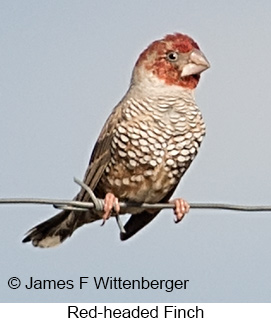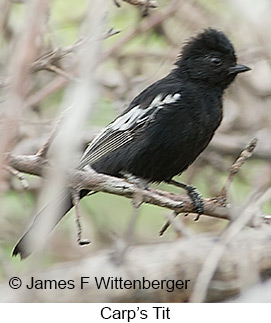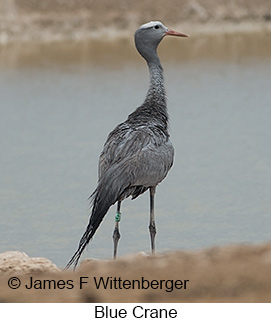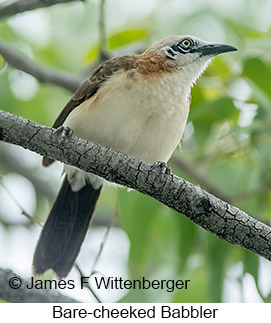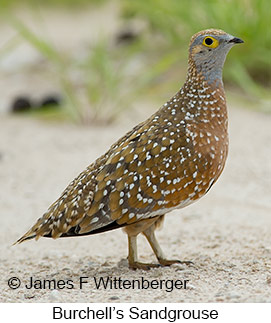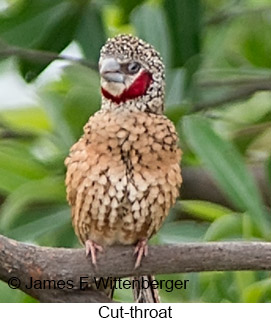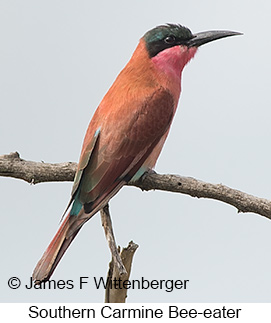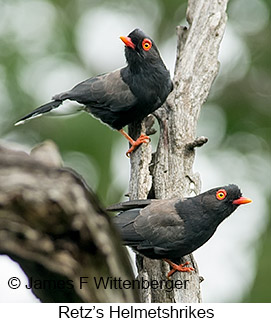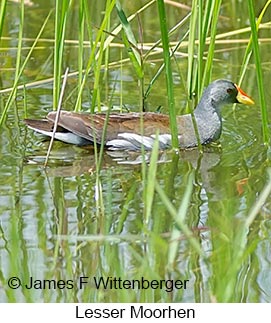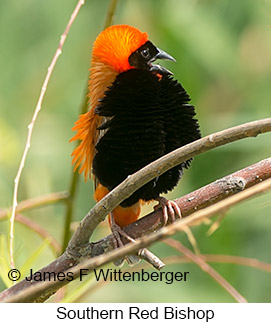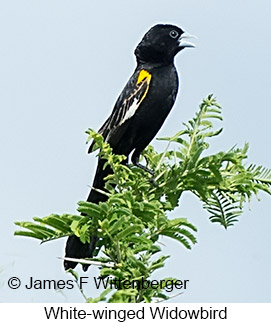NAMIBIA GRAND BIRDING & WILDLIFE TOUR
Tour Description

NAMIBIA
BIRDING TOUR
ANY TIME*
| Duration: | 18 days, 17 nights |
| Group Size: | 2-8 |
| Anytime Price: | $9450 |
| Group Price: | $6925 |
| Single Suppl: | $650 |
| Est #Species: | 350-400 |
| Pace: | Easy |
| Difficulty: | Easy |
| * This tour is available for any dates of your choosing provided guide services and accommodations are available. | |
DAY 1 - WINDHOEK & DAAN VILJOEN
Arrive in Windhoek by mid day. Birding near the arrivals area, best place to see Orange River Francolin and South African Swallow. Other possibilities include Little Swift, White-rumped Swift, Cape Wagtail, Southern Red Bishop, Black-faced Waxbill, Red-headed Finch, and Shaft-tailed Whydah. Then visit the sewage ponds on the edge of town. Birds of particular interest there are South African Shelduck, Hottentot Teal, Allen's Gallinule, Red-knobbed Coot, Three-banded Plover, White-throated Swallow, Great Reed Warbler, Rattling Cisticola, Zitting Cisticola, and Eastern Paradise-Whydah. Then drive to Daan Viljoen National Park, a small formerly private reserve 20min from Windhoek. Some late afternoon birding along and in the normally dry creek bed behind the lodge may turn up Spotted Eagle-Owl, Pearl-spotted Owlet, Crimson-breasted Gonolek, Golden-breasted Bunting, and Pin-tailed Whydah. Night at Sun Karros Lodge.
DAY 2 - DAAN VILJOEN & SPREETSHOOGTE PASS
Early morning game drive on the loop road. Likely mammals include Mountain Zebra, Southern Giraffe, Hartebeest, Blue Wildebeest, Springbok, and Gemsbok. Possible birds include Red-billed Francolin, Golden-tailed Woodpecker, Sabota Lark, Rufous-vented Warbler, Groundscraper Thrush, Mariqua Sunbird, and Lark-like Bunting. After breakfast depart for Spreetshoogte area, arriving at Namibgrens Guesthouse by lunch. Around the lodge we should find Karoo Scrub-Robin, Violet-backed Starling, Pale-winged Starling, and Dusky Sunbird. Late afternoon bird Spreetshoogte Pass. The main target bird is Herero Chat, always difficult and best found when it responds to playback. The pass is one of the best areas to find it. Other interesting possibilities include Pied Barbet, Cardinal Woodpecker, Bokmakierie, Chat Flycatcher, Short-toed Rock-Thrush, and Cape Wagtail. After dinner drive the road looking for nightjars and nocturnal animals such as Common Genet. Night at Namibgrens Guesthouse.
DAY 3 - SPREETSHOOGET PASS & WALVIS BAY
Before breakfast drive a ways along the gravel raod toward Solitaire looking for Chat Flycatcher, Kalahari Scrub-Robin, and Tractrac Chat. Also possible are mammals such as the very dark morph of Chacma Baboon, Red Hartebeest, and and Greater Kudu. After breakfast depart for Walvis Bay via Spreetshoogte Pass. Look again for Herero Chat if not seen the afternoon before. The pass drops steeply into very arid lowlands where birds such as Rüppell's Bustard, Namaqua Sandgrouse, Pygmy Falcon, Rock Kestrel, Greater Kestrel can be found. In the arid Naukluft Mountains and the edge of the Namib desert look for one of Namibia's two endemics, the Dune Lark. Visit a reliable spot for Kopje Warbler. Also possible there is Rockrunner, another elusive target species. Continue toward Windhoek, looking for the difficult Burchell's Courser as well as Gray's Lark and Stark's Lark en route. As time permits bird the coastal lagoon in Windhoek before dark. Night at Lagoon Loge.
DAY 4 - WALVIS BAY
Timing of activies this day depends on the tidal schedule. The coastal lagoon is best between low and high tides. A boat trip, probably after breakfast in the morning, is the best chance to see African Penguin. A colony of Brown (Cape) Fur Seals is likely to be active at Pelican Point. Depending on ocean temperatures the near endemic Benguela Dolphin may be present in the bay. Notable birds in the coastal lagoon include Greater Flamingo and Lesser Flamingo (numbers depend on the rains - in good rain years the flamingos move north into Etosha and other areas), Cape Teal, Three-banded Plover, White-fronted Plover, Chestnut-banded Plover, Bar-tailed Godwit, Curlew Sandpiper, Hartlaub's Gull, Kelp Gull, and Damara Tern, the latter a near endemic. In gardens near the lodge, the main target bird is Orange River White-eye. Night at Lagoon Loge.
DAY 5 - SPITZKOPPE & ERONGO MOUNTAINS
After breakfast depart for Swakopmund Salt Works where a million or more Cape Cormorants nest on "guano" platforms. The main target bird is Bank Cormorant, which is sometimes present in very small numbers. These birds are usually on banks around the settling ponds rather than on nesting platforms. The other main target bird is Gray's Lark, often present in the scrub vegetation around the salt works. Then transfer to Spitzkoppe, arriving in time for lunch. The very arid scrub along the way is a last chance to find Burchell's Courser and Gray's Lark if not seen earlier. Other possibilities en route include Rüppell's Bustard, Brown-crowned Tchagra, Spike-heeled Lark, and Red-capped Lark. At Spitzkoppe the main target birds are White-tailed Shrike, Karoo Long-billed Lark, Ashy Tit, and Herero Chat. Also possible are Verreaux's Eagle, Southern Fiscal, Yellow-bellied Eremomela, Tractrac Chat, and Mountain Wheatear. Then drive to the Erongo Mountains for an overnight stay. Some late afternoon birding may produce Rosy-faced Lovebird behind the bungalows. After dark look for Freckled Nightjars near the lodge. Night at Erongo Wilderness Lodge.
DAY 6 - ERONGO MOUNTAINS & WATERBERG
At first light look for the elusive Hartlaub's Francolin, normally only seen when its calling around dawn. Look for other specialties such as White-tailed Shrike, Carp's Tit, Ashy Tit, and Rockrunner. After breakfast depart for Waterberg Plateau. Damara Dikdik are likely to be evident on the access road on the way out. Birds such as Pale Chanting-Goshawk and Rufous-crowned Roller are often seen along the road. A stop at the sewage ponds in Otjiwarongo may produce White-faced Whistling-Duck, Southern Pochard, Sacred Ibis, and African Swamphen, African Jacana. Continue to Waterberg, looking for Steppe Eagle on telephone poles along the way. At Waterberg bird the access road where Pied Cuckoo, Swallow-tailed Bee-eater, Amur Falcon, Barred Wren-Warbler, Kalahari Scrub-Robin, Chestnut Weaver, and Green-winged Pytilia are among the possibilities. After arrival in late afternoon bird around the lodge. A major target species is Rüppell's Parrot. Other possibilities include African Hoopoe, Common Scimitarbill, Damara Red-billed Hornbill, Black-backed Puffback, Gray-backed Camaroptera, Red-backed Scrub-Robin, and Burchell's Starling. Night at Waterberg Resort.
DAY 7 - WATERBERG & ETOSHA NATIONAL PARK
Morning bird around the lodge. After breakfast depart for Etosha National Park. En route stop at a new site for Hartlaub's Francolin we discovered on my scouting trip. We had the closest views of the species my guide has ever experienced, and that in late morning rather than at dawn. Upon arrival and after check-in, drive the roads in the park. The western part of Etosha is much drier than the eastern part, so the birds are somewhat different. Birds of particular interest include Red-crested Bustard, White-quilled Bustard, Blue Crane, Spotted Thick-knee, Temminck's Courser, Double-banded Courser, White Helmetshrike, Spike-heeled Lark, Monotonous Lark, Rufous-naped Lark, Eastern Clapper Lark, Pink-billed Lark, White-breasted Sunbird, and Long-billed Pipit. Numerous raptors are also possible including Bateleur, Brown Snake-Eagle, Martial Eagle, and Pygmy Falcon. particular target bird around the lodge are Carp's Tit, Rufous-eared Warbler, and Black-faced Babbler. Mammals tend to be dispersed in years of good rains or concentrate around permanent water in dry years. Several water holes will be visited during the game drive, and a permanent water hole is also located directly behind the lodge where evening viewing of mammals can be productive in dry years. The famous "White" Elephants covered in white dust are in eastern Etosha. Encounters with predators are always possible. African Wild Dogs are not possible, but Cheetahs, Lions, and Leopards are. Night at Okaukuejo Lodge.
DAY 8 - ETOSHA NATIONAL PARK
Morning birding around the lodge. After breakfast another game drive in eastern Etosha followed by transfer to Halali. During the drive east the track skirts the vast Etosha pan, normally dry except in very wet years and large enough to be visible from space. Birding and game viewing en route. After check-in at Halali, birding around the lodge. The primary target bird is Bare-cheeked Babbler, typically present on the lawns or behind the lodge in dry scrub. Sometimes African Scops-Owl can be found roosting near the lodge. Other possibilities are Violet Woodhoopoe, Carp's Tit, Black-chested Prinia, and Cinnamon-breasted Bunting. Night at Halali Resort.
DAY 9 - ETOSHA NATIONAL PARK
Morning birding around the lodge. After breakfast game drive and transfer through the eastern section of Etosha. Upon arrival and after check-in at Mokuti Lodge, birding around the lodge. The lodge grounds offers another chance for Black-faced Babbler and is the best place for Cut-throat. Late afternoon game drive through the more lush bush of western Etosha. Night at Mokuti Lodge.
DAY 10 - ETOSHA NATIONAL PARK
All day game drives in the western section of Etosha. This section is especially good for Leopards. Possible birds include Swainson's Francolin, Crested Francolin, Lappet-faced Vulture, Steppe Eagle, Ovambo Sparrowhawk (most likely in years of good rains), Black-winged Pratincole, Burchell's Sandgrouse, Flappet Lark, Wattled Starling, Red-billed Quelea, and Eastern Paradise-Whydah. Night at Mokuti Lodge.
DAY 11 - ETOSHA & RUNDU
Morning birding around the lodge, last chance for Black-faced Babbler if missed earlier. Other possibilities include Black Cuckoo, Pied Cuckoo, Common Scimitarbill, African Golden Oriole, African Paradise-Flycatcher, Violet-backed Starling, White-breasted Sunbird, and Red-headed Weaver. After breakfast transfer to Rundu near the Angola border with birding stops en route. Main target birds are White-breasted Cuckooshrike, White-crowned Shrike, Rufous-bellied Tit, and Greencap Eremomela. The habitat around Rundu is more tropical. Trees are taller and riverine forest along the Okavango River is inhabited by species that barely reach Namibia. Outside Rundu along the road to the lodge, good possibilities include Magpie Shrike, Cut-throat, and Village Indigobird. Birding around the lodge typically yields Woodland Kingfisher, Blue-cheeked Bee-eater, Gabon Boubou, African Paradise-Flycatcher, Lesser Swamp Warbler, Hartlaub's Babbler, Arrow-marked Babbler, Kurrichane Thrush, Holub's Golden-Weaver, Village Weaver, Red-billed Firefinch. Also possible are Spectacled Weaver and Southern Brown-throated Weaver. Night at Nkwazi Lodge.
DAY 12 - RUNDU &OKAVANGO DELTA
After early morning birding and breakfast, depart for the Botswana border and Shakawe with birding en route. Possibilities include Dark Chanting-Goshawk, Shikra, African Hoopoe, Green Woodhoopoe, Meyer's Parrot, and Burchell's Starling. Stop for lunch at Popa Falls Resort. After lunch drive through the Mahango section of Bwabwata National Park, where Southern Carmine Bee-eaters are typically quite common, to the Botswana border. After clearing customs continue to Drotsky's Resort to catch the boat to its sister lodge, Xaro. Xaro Lodge is reached by a 45min boat transfer (longer with birding en route). Arrive at the lodge before dark. Night at Xaro Lodge.
DAY 13 - OKAVANGO DELTA
Morning birding around the lodge. The main target bird is Pel's Fishing-Owl, easier to see there than just about anywhere else. Then explore the Okavango delta by boat. A major target bird is the secretive and nocturnal White-backed Night-Heron. Local guides usually know where one or two are roosting deep in thickets along the shore. Numerous other birds are likely including Spur-winged Goose, African Pygmy-Goose, Goliath Heron, African Fish-Eagle, Water Thick-knee, Long-toed Lapwing, Coppery-tailed Coucal, Malachite Kingfisher, Giant Kingfisher, and Grosbeak Weaver. Also possible though rather shy are African Clawless Otters. Birding around the lodge in the afternoon and following morning may produce Red-faced Mousebird, Narina Trogon, Broad-billed Roller, Crested Barbet, Black-collared Barbet, Retz's Helmetshrike, Black Cuckooshrike, Collared Sunbird, and Purple-banded Sunbird. After nightfall try for African Barred Owlet. Night at Xaro Lodge.
DAY 14 - OKAVANGO DELTA & POPA FALLS
Morning birding around Xaro Lodge. After breakfast transfer by boat back to Drotsky's and then by land back across the Botswana border to Popa Falls. Afternoon game drive into Mahango section of Bwabwata National Park, where African Wild Dogs are a distinct possibility. This section of the park is the western-most limited of several specialties including Wattled Crane, Lesser Jacana, and Black Coucal. Night at Popa Falls Resort.
DAY 15 - POPA FALLS & KATIMA MULILO
Early birding around the lodge. After breakfast transfer to Katima Mulilo on the Zambia border with birding en route. The most important target birds are Dickinsons' Kestrels, which normally perch in dead trees, and Greencap Eremomela. Also possible are the secretive Lesser Moorhen in wetlands, most easily seen during years of good rains, Bradfield's Hornbill, Southern Red-billed Hornbill, Meyer's Parrot, White Helmetshrike, and Yellow-crowned Bishop. Arrive in Katima Mulilo by lunch. The most important target bird around the lodge is Schalow's Turaco. Afternoon boat trip on the Zambezi River. This section of the river is one of the best places to see African Finfoot, almost always seen. The secretive White-backed Heron is also regularly seen. Other interesting birds along the river include White-faced Whistling-Duck, Great Cormorant, Trumpeter Hornbill, Brown-hooded Kingfisher, and Giant Kingfisher. More difficult but sometimes seen are Half-collared Kingfisher and African Pygmy-Kingfisher. Night at Caprivi River Lodge.
DAY 16 - KATIMA MULILO & LIVINGSTONE
Morning birding around the lodge grounds. Possibilities include Hadada Ibis, Yellow-fronted Tinkerbird, Sulphur-breasted Bushshrike, Arrow-marked Babbler, Ashy Flycatcher, Red-backed Scrub-Robin, Copper Sunbird, Southern Red Bishop, and Bronze Mannikin. After breakfast depart for the Zambia border and then Livingstone. The border crossing can be time consuming, and the first 100km of road in Zambia is poorly maintained so is slow going. Arrive in Livingstone by lunch. Afternoon either visit Victoria Falls or bird the sewage ponds outside town. The Zambezi River flows west to east so the best time to visit the falls is probably the following morning unless weather conditions dictate otherwise. The sewage ponds are a good place to look for Lesser Jacana. Other possibilities include White-browed Coucal, Striped Kingfisher, Broad-billed Roller, and White-winged Widowbird. A visit to a lodge near the ponds is a reliable place for Bearded Scrub-Robin. Also possible there is Red-winged Starling and Orange-winged Pytilia. Night at Protea Hotel.
DAY 17 - VICTORIA FALLS & DEPARTURE
Morning visit to the spectacular Victoria Falls. Depending on the time of year and rains in Angola, the falls may have tremendous amounts of water that obscure visibility or may be totally visible. In morning sun double rainbows in the spray are a common appearance. The morning is not without target birds. Key species is Natal Francolin. A rarity that may be possible if there isn't too much spray over the falls is Taita Falcon. It's also a last chance for Jameson's Firefinch if it hasn't been found earlier in the tour. End of tour at the airport. Afternoon flight out, presumably to connecting international flight in Johannesburg.
DAY 18 - INTERNATIONAL FLIGHT HOME
Typically, overnight flight, arriving next morning for connection to domestic flight home.
ADDITIONAL INFO
(Not on Menu Above)
BIRDING LOCALES
